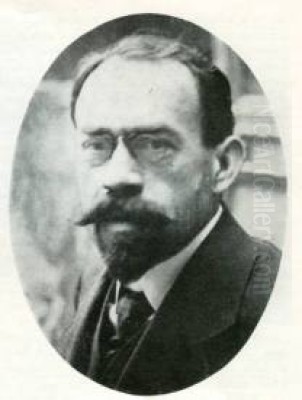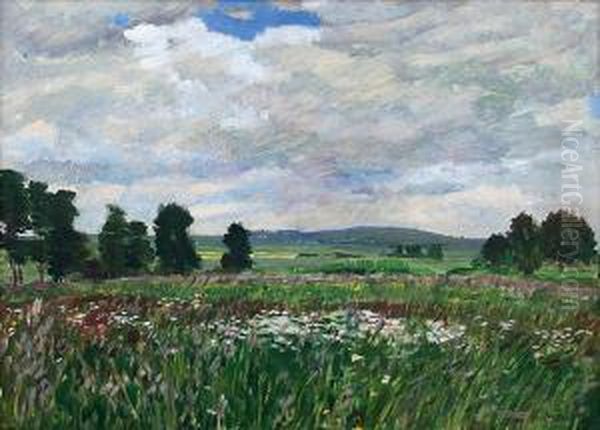
Antonín Hudeček stands as a significant figure in the narrative of Czech art, particularly renowned for his evocative landscape paintings that bridged the 19th-century traditions with the burgeoning spirit of modernism in the early 20th century. Born in 1872 and passing away in 1941, his life spanned a period of immense artistic and social change in Bohemia, later Czechoslovakia. Hudeček's dedication to capturing the essence of the Czech landscape, imbued with mood and atmosphere, cemented his place as a key member of a generation that sought a distinct national artistic identity.
Early Life and Artistic Formation
Antonín Hudeček was born in Loucká near Ředhošť, Bohemia (now part of the Czech Republic), on January 14, 1872. His artistic inclinations led him to the prestigious Academy of Fine Arts in Prague. There, he initially studied figurative painting under Professor Maxmilián Pirner, a notable figure painter and illustrator. He also spent time in the studio of Václav Brožík, a celebrated painter known for his large-scale historical canvases, representing a more academic tradition.
However, Hudeček's true passion lay in landscape painting. This drew him to the specialized landscape school within the Academy, led by the influential Julius Mařák. Mařák was a pivotal figure in Czech landscape art, fostering a style that emphasized atmospheric realism and lyrical interpretations of nature. Hudeček became one of Mařák's most prominent pupils, absorbing the master's sensitivity to light, mood, and the specific character of the Bohemian countryside. His training was further broadened by a period spent studying at the Academy of Fine Arts in Munich, exposing him to different artistic currents prevalent in Germany at the time.
The Mánes Union and the Rise of Modernism

Hudeček's artistic development coincided with a crucial period in Czech art history marked by the activities of the Mánes Union of Fine Arts (Spolek výtvarných umělců Mánes). Founded in 1887, the Mánes Union became a vital platform for progressive artists seeking to break away from the conservative constraints of the official Prague establishment. It championed new styles like Impressionism, Symbolism, and Art Nouveau, organizing influential exhibitions that introduced international trends to the Czech public.
Hudeček became closely associated with the Mánes Union, exhibiting regularly with the group. He found himself among a generation of artists, many also pupils of Mařák or influenced by his school, who were forging a modern Czech identity in art. Key contemporaries within this circle included Antonín Slavíček, arguably the most celebrated Czech Impressionist landscape painter, and Jan Preisler, a leading figure of Czech Symbolism and modern figurative painting. Their collective efforts helped shift the center of Czech art towards more modern sensibilities.
Master of the Czech Landscape
Landscape painting remained the cornerstone of Hudeček's oeuvre throughout his career. He possessed a deep connection to the natural world, particularly the varied terrains of his homeland. He was drawn to the specific atmospheres of different regions and seasons, translating them onto canvas with remarkable sensitivity. His approach evolved from the detailed realism learned under Mařák towards a looser, more expressive style influenced by Impressionism, particularly in his handling of light and color.
He often sought inspiration in specific locales. The area around Okoř Castle, near Prague, was a favorite subject, providing motifs of rolling hills, ponds, and rural architecture. He also spent significant time painting in the Police nad Metují region and traveled for inspiration, including trips to Italy and Sicily in 1902, and later to the Balkans. These travels sometimes introduced different light conditions and motifs, but his core focus remained the lyrical interpretation of landscape, often imbued with a sense of melancholy or quiet contemplation.
Hudeček's landscapes are rarely just topographical records. They are infused with mood, often capturing the transient effects of weather – the aftermath of rain, the haze of autumn, the thaw of spring snow. He excelled at depicting water, forests, and the interplay of light and shadow. His work often resonates with what the Germans call "Stimmung," an untranslatable term referring to atmosphere, mood, and ambiance, a quality highly valued in Central European landscape painting of the era.
Stylistic Evolution and Influences
While often categorized broadly within the Mařák school or associated with Czech Impressionism, Hudeček's style was more complex and evolved over time. His early works show a clear debt to Mařák's atmospheric realism. By the early 1900s, his brushwork became bolder, his palette brightened, and his focus shifted towards capturing fleeting moments of light and color, aligning him with Impressionist tendencies, though perhaps less systematically than his contemporary Antonín Slavíček.
The provided source materials also link Hudeček to "Traditionalism." This likely refers to his continued commitment to representational landscape painting and traditional techniques (like oil on canvas) in an era when more radical avant-garde movements like Cubism and abstract art were emerging, championed by artists like Emil Filla, Bohumil Kubišta, and František Kupka. While Hudeček engaged with modernism, he did not embrace its most extreme forms, preferring to synthesize modern sensibilities with his established landscape focus.
Symbolist elements also permeate Hudeček's work, particularly in the evocative moods and emotional resonance of his landscapes. While not typically employing overt symbols like Jan Preisler or Max Švabinský, his paintings often convey deeper feelings about nature, solitude, and the passage of time. Some sources even mention connections to Expressionism and Civilism, suggesting an awareness of these broader European trends, perhaps reflected in a heightened emotional intensity or occasional focus on more structured, simplified forms in later works. His exploration of city night scenes also points to an engagement with modern urban themes.
Notable Works and Themes
Several specific works highlight Hudeček's artistic journey and thematic concerns. Chalupa (Cottage or Farmhouse), dated around 1906-1907, is cited as a significant early modern work, likely embodying his connection to the rural Czech landscape and perhaps hinting at the theme of simple, traditional life. This focus on humble dwellings and the lives connected to the land touches upon the source's mention of his interest in "human poverty and need," expressed through the context of the landscape.
Rybník na podzim (Pond in Autumn), exhibited in Prague, exemplifies his skill in capturing seasonal moods and reflections on water, a recurring motif. Les po dešti (Forest after Rain) showcases his ability to render the specific atmosphere of the woods after a downpour, focusing on damp earth, glistening leaves, and filtered light. This work's significance is underscored by its designation as a national cultural monument by the Czech Ministry of Culture in 1997.
The painting Tání na Bělé (Thaw on the Bělá River), dated circa 1935, represents his mature style. Its relatively large dimensions (106.5 x 155 cm) and execution in oil suggest a major work from his later period, likely continuing his exploration of seasonal change and the specific character of Czech river landscapes. Other mentioned works like Krajina s procesím (Landscape with Procession) and Horská krajina s kvetoucím vřesovištěm (Mountain Landscape with Blooming Heather) further indicate the breadth of his landscape subjects.
Contemporaries and Artistic Milieu
Hudeček operated within a rich and dynamic artistic environment. Besides his close Mánes colleagues Slavíček and Preisler, and his teacher Mařák, the Czech art scene pulsed with diverse talents. Alfons Mucha was achieving international fame with his distinct Art Nouveau style. Max Švabinský excelled in portraiture and graphic arts.
The generation that followed Hudeček pushed Czech art further into the European avant-garde. František Kupka became a pioneer of abstract art in Paris. Emil Filla, Bohumil Kubišta, Josef Čapek (brother of the writer Karel Čapek), Antonín Procházka, and the sculptor Otto Gutfreund were central figures in Czech Cubism and Expressionism. Václav Špála developed a highly recognizable, vibrant Fauvist-inspired style. Jan Zrzavý forged a unique path blending Symbolism, early Italian influences, and a dreamlike modernism. Otakar Kubín (known internationally as Othon Coubine) also emerged from this milieu, later finding success in France. Hudeček's more lyrical, landscape-focused modernism provides a contrast to these often more radical paths, yet he remained a respected figure within this vibrant scene.
Later Years and Lasting Legacy
Antonin Hudeček continued to paint and exhibit throughout his life. His participation in the 1909 exhibition in Staré Kolíno, at the invitation of fellow artist Rudolf Bém, indicates his active role in the artistic community. His work remained rooted in the Czech landscape tradition he had helped to modernize. While perhaps overshadowed in international narratives by the more avant-garde Czech artists, his contribution to the national school of painting is undeniable.
His legacy lies primarily in his mastery of atmospheric landscape painting. He successfully navigated the transition from 19th-century realism to a modern sensibility informed by Impressionism and Symbolism, without abandoning representation. He captured the soul of the Czech countryside with a unique blend of observation and poetic feeling. His work influenced subsequent generations of Czech landscape painters who continued to explore the national terrain.
Antonin Hudeček passed away in Častolovice on August 11, 1941. His paintings remain highly regarded in the Czech Republic, held in major collections like the National Gallery Prague, and appreciated for their technical skill and profound connection to the spirit of the Czech land. He stands as a testament to the enduring power of landscape painting and a crucial link in the evolution of modern Czech art. His dedication to his chosen genre and his ability to infuse it with subtle emotion and light secure his position as a significant and enduring figure in Central European art history.